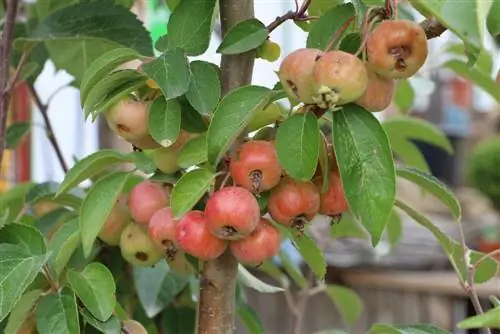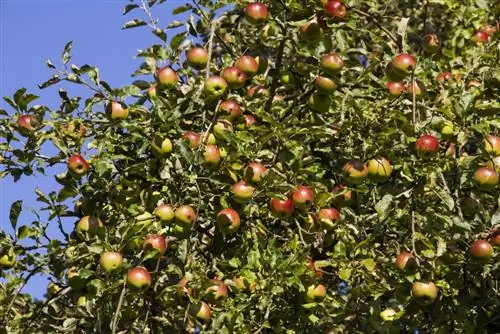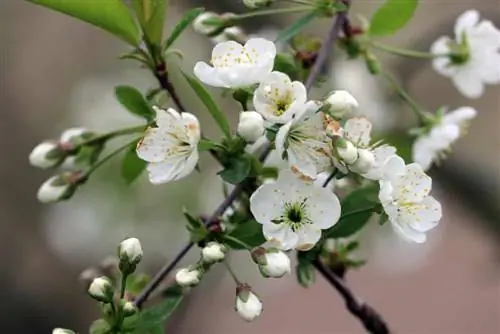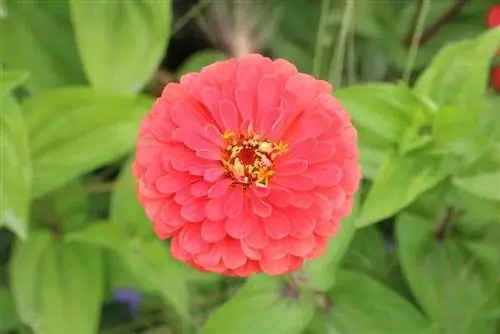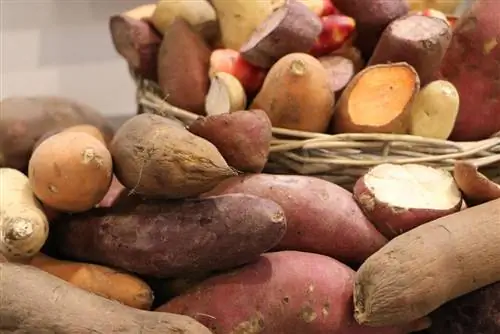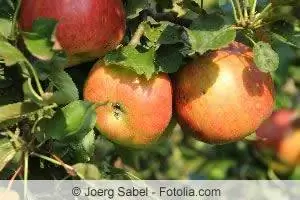- Author admin [email protected].
- Public 2023-12-17 03:39.
- Last modified 2025-06-01 06:48.
The columnar apple tree (more rarely: columnar apple) takes up very little space, but works hard for the offspring, i.e. its apples. It is more of a candidate for the small, fine garden. It also cuts a good (pillar-shaped) figure on the balcony and terrace. Nevertheless, it demands at least as much attention as its primitive relatives. Depending on the variety, it grows between two and four meters high and is only 50 centimeters wide, which explains the name columnar apple tree for this type of shaped fruit.
Location & Soil
Freeland
Most of the time the columnar apples are placed in the field. The right choice of location is crucial for the highest possible harvest yield. A partially shaded to sunny location is ideal. Sufficient sunlight is particularly important for the development of the fruits. The less sun, the fewer flowers and fruits. The columnar apple tree looks good as a solitary plant, but you should keep in mind that, like normal apple trees, it is generally not self-pollinating. He needs another apple tree somewhere in the neighborhood.
Visually, it makes a magnificent impression in company, for example planted as a hedge or small privacy screen for a seating area. An exclusive and tasty eye-catcher, also for bees and numerous flying nectar collectors.
Substrate
The demands on the soil are medium high. They are not much different from those of many other useful and ornamental plants in the garden. Deep, loose and water-permeable garden soil is best suited. However, compacted, predominantly clayey soil is unsuitable. Before planting, generously mixing the garden soil with rich compost is ideal.
Bucket
The columnar apple tree also feels at home in the pot. What's more, if you take a few care tips into account, it even bears fruit and is therefore an ornamental and useful tree at the same time.
Who has an apple tree on their balcony?
When shopping, you can choose weak-growing, smaller varieties that are well suited for planters. The columnar apple requires a large container, at least 30 liters. The pot should not stand directly on the ground, but rather on small terracotta feet or something similar. This allows the water to drain better. Please note the following when potting:
- good drainage
- Substrate: loose, slightly acidic
- suitable: potted plant soil, sand, primary rock powder
- approx. repot every five years
- fill missing soil
- Avoid waterlogging
- protect in winter: with fleece, mulch
Tip:
Place under cover (protected from rain) from emergence (March) until the beginning of June. This is a good prevention against scab fungus. But insects must have free access.
Pouring
A little sensitivity is required when pouring. The better the drainage is, the looser and more permeable the soil, the more likely mistakes are to be forgiven. At least when it comes to too much water. It is important to avoid waterlogging as well as drying out of the plant ball.
Basically, the columnar apple needs a lot of moisture, especially when the fruit is ripening. It may also be necessary to moisten the leaves at this time if the weather is very dry for a long period of time. Especially on dry days or when a lot of wind dries out the leaves and soil, it appreciates being misted with a water sprayer or hose. In winter, the columnar apple tree can be watered moderately on dry, frost-free days.
Fertilize
In the best case scenario, the columnar apple tree delivers a rich harvest in the smallest of spaces. Due to its growth habit, with almost no side branches and a correspondingly low leaf mass, it has to get a lot of strength from the earth. In other words, the nutrient requirement is great and fertilization is mandatory for a rich harvest.
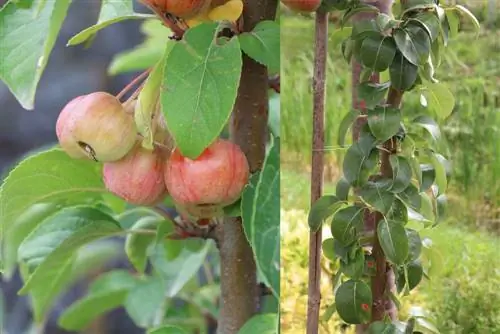
Putting in a little compost once a year is not enough. The general recommendation is therefore to also incorporate a nitrogen-based long-term fertilizer for fruit in the spring when budding begins. In August, a fertilizer with a high potassium content ensures more resistance to frost. It promotes woodiness.
In the bucket it is even more important to supply the columnar apple with nutrients. The easiest way to do this is to provide it with a liquid fertilizer in the irrigation water every two weeks. In spring and autumn, adding horn shavings or compost can improve the substrate.
Cutting
If you want to preserve the characteristic shape of the columnar apple and hope for the richest possible harvest in autumn, you should also pay attention to the correct cut. Radical cuts are a no-go, as is the motto “just let it grow.”
As a rule, the columnar apple tree grows upwards on a single shoot. The crown tapers quite narrow towards the top. If you want them to be a little fuller, you can go for two or more central shoots, but you should know that this has a negative impact on the apple harvest, both qualitatively and quantitatively.
If you still want to branch upwards or if the central shoot has grown too high (after 8 years at the earliest), it is best to do this cutting (deriving) in August, then the new growth will not be as strong. The cut is capped above an eye that points straight to the side.
The best time for normal pruning is in February and March, before the tree sprouts again. Get to work with a sharp, clean cutting tool:
- remove dead branches
- remove woody, diseased branches
- remove long, straight water shoots
- remove side shoots growing upwards
- Remove side shoots that are longer than 20 cm
- remove cross-growing branches
- shorten side branches that are too long
Tip:
During pruning work you should always keep the entire appearance of the columnar apple tree in mind.
In order to obtain as many he althy apples as possible, thinning must be carried out again during the beginning of fruit formation. This essentially separates the fruits and the remaining fruits have a better chance of ripening into a tasty, he althy fruit.
Harvest
From a professional point of view, the apple harvest does not come close to the harvest of conventional apple trees in terms of yield, taste and storage stability. However, the fruits of the columnar apple trees leave little to be desired for the needs of the family. The time of harvest, for most varieties in September, should therefore be timed as optimally as possible. In most cases, consuming them quickly or processing them into puree, jelly or juice is cheaper than trying to let them ripen or store them for longer.
Tip:
Varieties with colored flesh (e.g. Baya Marisa) are particularly good when processed into apple jelly.
Diseases & Pests
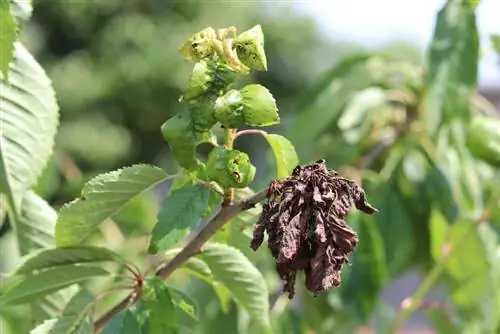
Unfortunately, diseases and pests do not stop at the columnar apple tree. That's why a good location and careful care are very important. Nobody wants to work with chemicals in their garden, especially not when it comes to crops.
Apple scab
An infestation can be recognized by velvety, gray or brown spots on the fruits. The spots dry and become scabby and crack. This results in deformed fruits. Leaves and shoots die. As a precaution, it is important that the water on the leaves can drain away easily after rain or after moistening. This means that an airy location is required. When planting in groups or rows, the trees must not be too close together. Planting distance approx. 50 centimeters.
Mildew
Powdery mildew is another threat to the he alth of the columnar apple. Regular inspection of the leaves and shoots is the best way to combat this. It appears as a whitish-gray coating on the leaves. Infected leaves, shoots and twigs must be cut off and destroyed immediately. Spraying regularly with a decoction of garlic or nettle strengthens the plant against fungal diseases.
Apple Blossom Picker
The apple blossom beetle is a beetle that targets the flowers. An infestation can be recognized by prematurely dried flower buds. Without chemicals, the only thing left to do is to contain the population of these weevils as much as possible by collecting them.
codling moth
The codling moth is a maggot that targets the finished fruit. There are a few tricks here to contain the inventory:
- Collecting the visible animals
- Setting up pheromone traps
- spray regularly with wormwood broth or nettle manure
- attach a fruit maggot catch belt
Aphids
The ubiquitous aphids also attack fruit trees. They can be easily identified by the young stems and shoots. Once you have spotted aphids, you need to take immediate action and remove the affected parts of the plant. Otherwise, the usual gentle measures against aphids help: nettle decoction, soapy water and the use of natural predators.
Varieties
The current varieties of the columnar apple tree all go back to a mutation of the old cultivar McIntosh. Added to this was the skill of the gardeners at the time. Among other things, they discovered the columnar shape as a special and elegant variant of the normal apple tree and experimented with other varieties.

The shape is in the genes of the columnar apple trees. Therefore, there is no need to put too much effort into maintaining this shape today. Another plus point is that the columnar apple tree was not only bred to become an ornamental tree, but that many varieties also placed emphasis on a rich and tasty harvest.
Today, when purchasing a columnar apple tree, you are spoiled for choice when it comes to the appearance of the fruit and the taste. There are varieties that focus on beautiful growth, shiny leaves and small, pretty, firm fruits. When it comes to robustness, there are varieties with different levels of sensitivity. Especially when the site conditions are not ideal and for potted plants, it is worth making your selection with these aspects in mind. There are also varieties that are well and less well suited for a hedge or row planting.
A variety overview with the most important properties:
- ‘Arbat’ - medium-sized, juicy-sweet apples; very slender stature; robust
- ‘Baya Marisa’ - red, medium-sized, very sweet apples; red-fleshed fruit; frost hardy
- ‘Black McIntosh’ - dark red, sweet, juicy, medium-sized apples; suitable for beginners
- ‘Cactus’ - yellow-green, sweet and sour apples; frost hardy; 2nd generation of 'Tuscan'
- ‘Charlotte’ - green-red, aromatic apples; 1st generation
- ‘Ginover’ - tart, red fruits; high yield; good storage stability; well suited for baking
- ‘Goldcats’ - yellow, sweet apples; frost hardy; 2nd generation of 'Telamon'
- ‘Golden Gate’ - yellow-red, sweet apples; very slender stature; well suited for pots;
- ‘Goldlane’ - yellow, juicy, sweet apples; high yield; good storage stability; scab resistant;
- ‘Greencats’ - green, sweet and sour apples; storable; pretty tough; 2nd generation of 'Tuscan'
- ‘Maypole’ - ornamental variety; short stature; fungus resistant; small fruits; 1st generation
- ‘Moonlight’ - green, spicy, sweet and sour apples; robust; early variety; 2nd generation of 'Tuscan'
- ‘Pomfit’ - bright red, medium-sized, delicately tart apples; high, regular yield; 2nd generation of 'Maypole'
- ‘Pomfital’ - dark red, small apples with red flesh; fungus resistant; 2nd generation of 'Maypole'
- 'Pomforyou' ('Lancelot')' - red-yellow, acidic apples; high yield; robust; 2nd generation of 'Maypole'
- ‘Pomgold’ - green, juicy, sweet apples; high yield; not scab resistant; 2nd generation of 'Telamon'
- 'Pompink'('Ginover') - red-green, aromatic apples; high yield; beautiful rich flowers; 2nd generation of 'Obelisk' crossed with the apple 'Topaz'
- ‘Pomredrobust’ - red-yellow, tart apples; pretty tough; 2nd generation of 'Telamon'
- ‘Primo’ (Campanula series) - red-yellow, finely aromatic, medium-sized apples; very robust
- ‘Red Lane’ - red-flowering, red-leaved; ornamental variety; short stature; small fruits with reddish flesh; 2nd generation of 'Maypole'
- ‘Red River’ - red-yellow, large, spicy apples; few side branches, therefore easy to cut; high growth; robust
- ‘Redcats’ - red-yellow, sweet-tart apples; robust; frost hardy; 2nd generation of 'Telamon'
- ‘Rhapsody’ - red-yellow, aromatic apples; weak, compact growth; 2nd generation of 'Tuscan'
- ‘Rondo’ - sweet-sour, red, large apples; high yield; good storage stability; resistant to scab and mildew; 2nd generation of 'Tuscan'
- ‘Rotbäckchen’ - dark red, slightly sour apples; very suitable for pots; gorgeous yellow autumn leaves
- ‘Silver Pearl’ - ornamental variety; small, orange-red, sweet and sour apples; decorative flower; robust
- ‘Sonata’ - green-yellow, medium-sized, juicy apples; weak, narrow growth, well suited for pots; 2nd generation of 'Tuscan'
- ‘Starcats’ - red, firm, sweet and sour apples; particularly robust against diseases and aphids; 2nd generation of 'Tuscan'
- ‘Suncats’ - red, mildly sour apples; robust; frost hardy; 2nd generation of 'Telamon'
- ‘Sunlight’ - red, medium-sized, aromatic apples; scab resistant; 2nd generation of 'Telamon'
The 1st generation varieties, also called ballerinas, have dance-related names such as 'Bolero', 'Flamenco', 'Polka' and 'W altz'. When it comes to the taste of their fruits, their robustness and resistance to disease, they can no longer compete with subsequent generations.
Conclusion
The variety of varieties shows that there must be a sworn fan base for the columnar fruit among professionals and hobby gardeners. They are not yet seen that often in gardens or on balconies. With their unusual growth habit, they are a very special eye-catcher, especially in spring and autumn. The fruits of the smaller ornamental varieties, which are particularly suitable for planters, also taste quite good.

